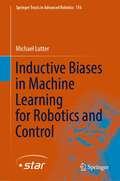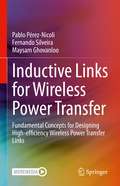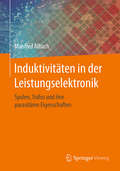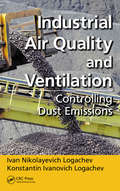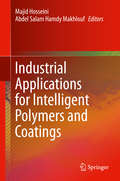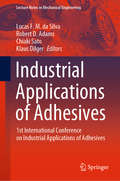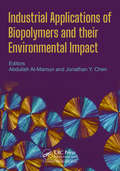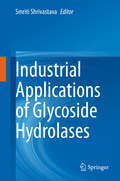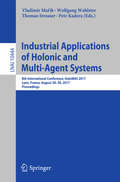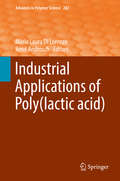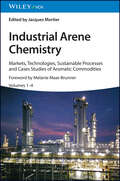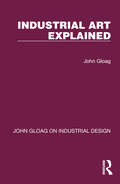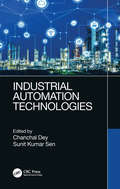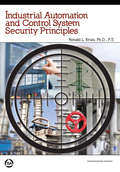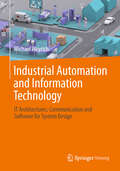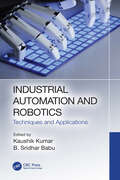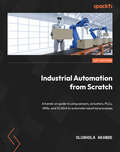- Table View
- List View
Inductive Biases in Machine Learning for Robotics and Control (Springer Tracts in Advanced Robotics #156)
by Michael LutterOne important robotics problem is “How can one program a robot to perform a task”? Classical robotics solves this problem by manually engineering modules for state estimation, planning, and control. In contrast, robot learning solely relies on black-box models and data. This book shows that these two approaches of classical engineering and black-box machine learning are not mutually exclusive. To solve tasks with robots, one can transfer insights from classical robotics to deep networks and obtain better learning algorithms for robotics and control. To highlight that incorporating existing knowledge as inductive biases in machine learning algorithms improves performance, this book covers different approaches for learning dynamics models and learning robust control policies. The presented algorithms leverage the knowledge of Newtonian Mechanics, Lagrangian Mechanics as well as the Hamilton-Jacobi-Isaacs differential equation as inductive bias and are evaluated on physical robots.
Inductive Links for Wireless Power Transfer: Fundamental Concepts for Designing High-efficiency Wireless Power Transfer Links
by Fernando Silveira Pablo Pérez-Nicoli Maysam GhovanlooThis book presents a system-level analysis of inductive wireless power transfer (WPT) links. The basic requirements, design parameters, and utility of key building blocks used in inductive WPT links are presented, followed by detailed theoretical analysis, design, and optimization procedure, while considering practical aspects for various application domains. Readers are provided with fundamental, yet easy to follow guidelines to help them design high-efficiency inductive links, based on a set of application-specific target specifications. The authors discuss a wide variety of recently proposed approaches to achieve the maximum efficiency point, such as the use of additional resonant coils, matching networks, modulation of the load quality factor (Q-modulation), and adjustable DC-DC converters. Additionally, the attainability of the maximum efficiency point together with output voltage regulation is addressed in a closed-loop power control mechanism. Numerous examples, including MATLAB/Octave calculation scripts and LTspice simulation files, are presented throughout the book. This enables readers to check their own results and test variations, facilitating a thorough understanding of the concepts discussed. The book concludes with real examples demonstrating the practical application of topics discussed.Covers both introductory and advanced levels of theory and practice, providing readers with required knowledge and tools to carry on from simple to advanced wireless power transfer concepts and system designs;Provides theoretical foundation throughout the book to address different design aspects;Presents numerous examples throughout the book to complement the analysis and designs;Includes supplementary material (numerical and circuit simulation files) that provide a "hands-on" experience for the reader;Uses real examples to demonstrate the practical application of topics discussed.
Inductors and Transformers for Power Electronics
by Vencislav Cekov Valchev Alex Van den BosscheAlthough they are some of the main components in the design of power electronic converters, the design of inductors and transformers is often still a trial-and-error process due to a long working-in time for these components. Inductors and Transformers for Power Electronics takes the guesswork out of the design and testing of these systems and provides a broad overview of all aspects of design.Inductors and Transformers for Power Electronics uses classical methods and numerical tools such as the finite element method to provide an overview of the basics and technological aspects of design. The authors present a fast approximation method useful in the early design as well as a more detailed analysis. They address design aspects such as the magnetic core and winding, eddy currents, insulation, thermal design, parasitic effects, and measurements. The text contains suggestions for improving designs in specific cases, models of thermal behavior with various levels of complexity, and several loss and thermal measurement techniques.This book offers in a single reference a concise representation of the large body of literature on the subject and supplies tools that designers desperately need to improve the accuracy and performance of their designs by eliminating trial-and-error.
Induktivitäten in der Leistungselektronik
by Manfred AlbachInduktive Bauelemente spielen eine Schlüsselrolle bei der Entwicklung von Netzgeräten, Wechselrichtern und anderen leistungselektronischen Systemen. Das Lehrbuch beschäftigt sich intensiv mit der Berechnung der parasitären Eigenschaften von Spulen und Transformatoren in Abhängigkeit von ausgewähltem Kern (Geometrie und Material), Wickelgut (Runddraht, Litze, Folie) und internem Aufbau, d.h. Positionierung der Wicklungen im Wickelfenster. Schwerpunkte bilden die unterschiedlichen Verlustmechanismen in Kern und Wicklung, die induktiven und kapazitiven Kopplungen sowie das EMV-Verhalten dieser induktiven Komponenten.
Industrial AI: Applications with Sustainable Performance
by Jay LeeThis book introduces Industrial AI in multiple dimensions. Industrial AI is a systematic discipline which focuses on developing, validating and deploying various machine learning algorithms for industrial applications with sustainable performance. Combined with the state-of-the-art sensing, communication and big data analytics platforms, a systematic Industrial AI methodology will allow integration of physical systems with computational models. The concept of Industrial AI is in infancy stage and may encompass the collective use of technologies such as Internet of Things, Cyber-Physical Systems and Big Data Analytics under the Industry 4.0 initiative where embedded computing devices, smart objects and the physical environment interact with each other to reach intended goals. A broad range of Industries including automotive, aerospace, healthcare, semiconductors, energy, transportation, mining, construction, and industrial automation could harness the power of Industrial AI to gain insights into the invisible relationship of the operation conditions and further use that insight to optimize their uptime, productivity and efficiency of their operations. In terms of predictive maintenance, Industrial AI can detect incipient changes in the system and predict the remains useful life and further to optimize maintenance tasks to avoid disruption to operations.
Industrial Air Quality and Ventilation: Controlling Dust Emissions
by Ivan Nikolayevich Logachev Konstantin Ivanovich LogachevIn the field of industrial ventilation and air quality, a lack of adequate analysis for aerodynamic processes, as well as a shortage of properly equipped computer facilities, has forced specialists to rely on an empirical approach to find answers in the past. Commonly based on crude models, practical data, or countertypes, the answers often offered
Industrial Applications
by Martin HofrichterThis volume gives a survey of the state of the art in the traditional fields of industrial mycology as well as of selected novel applications of fungi. The first section deals with the use of fungi in the production and processing of bread, cheese, beer and wine, traditional Asian fermentation products and edible mushrooms. The second section is devoted to the production of fungal metabolites and enzymes representing value-added products. In addition to antibiotics, alkaloids organic acids, vitamins and industrial enzymes, which have successfully been in use for decades, it is also dedicated to fungal metabolites, such as insecticidal and nematicidal compounds, immunosurppressants and flavors with promising biotechnological potential. In the next section, the recent developments in fungal biotransformation of small molecules, the bioconversion of lignocelluloses as well as the use of fungi in metal recovery are presented. The final part introduces some innovative new trends in the field of applied mycology: the preparation of fungal bioherbicides, recent genomic approaches for the identification of biopolymer degrading enzymes, current developments in using oxidative enzymes from fungi as well as new attempts to transfer fungal remediation technologies into practice.
Industrial Applications for Intelligent Polymers and Coatings
by Majid Hosseini Abdel Salam Hamdy MakhloufThis book is a comprehensive collaboration on intelligent polymers and coatings for industrial applications by worldwide researchers and specialists. The authors cover the basis and fundamental aspects of intelligent polymers and coatings, challenges, and potential mechanisms and properties. They include recent and emerging industrial applications in medical, smart textile design, oil and gas, electronic, aerospace, and automobile industries as well as other applications including microsystems, sensors, and actuators, among others. The authors discuss the potential for future research in these areas for improvement and growth of marketable applications of intelligent polymers and coatings.
Industrial Applications of Adhesives: 1st International Conference on Industrial Applications of Adhesives (Lecture Notes in Mechanical Engineering)
by Robert D. Adams Chiaki Sato Lucas F. M. da Silva Klaus DilgerThis book gathers selected papers presented at the 1st International Conference on Industrial Applications of Adhesives 2020 (IAA 2020). It covers a wide range of topics, including adhesive curing for electronic and automotive industries; adhesive testing with a torsion machine for rigorous mechanical properties determination; joint design using innovative techniques such as the meshless method; design methodologies in the automotive industry for joints under impact; temperature effects in joints typically found in civil engineering; and advanced nondestructive techniques such as terahertz spectroscopy to assess the durability of adhesive joints. Providing a review of the state-of the art in industrial applications of adhesives, the book serves as a valuable reference resource for researchers and graduate students interested in adhesive bonding.
Industrial Applications of Biopolymers and their Environmental Impact
by Abdullah Al-Mamun; Jonathan Y. ChenBiopolymers represent a carbon emission solution: they are green and eco-friendly with a variety of uses in biomedical engineering, the automotive industry, the packaging and paper industries, and for the development of new building materials. This book describes the various raw materials of biopolymers and their chemical and physical properties, the polymerization process, and the chemical structure and properties of biopolymers. Furthermore, this book identifies the drawbacks of biopolymers and how to overcome them through modification methods to enhance the compatibility, flexibility, physicochemical properties, thermal stability, impact response, and rigidity.
Industrial Applications of Glycoside Hydrolases
by Smriti ShrivastavaThis book gathers selected studies on the industrial applications of glycoside hydrolases (GHs), presenting an updated classification of these enzymes, and discussing their structure, mechanisms, and various approaches to improve their catalytic efficiency. Further, it explains the various industrial applications of glycoside hydrolases in food, effluent treatment, biofuel production, and the paper and pulp industries. Lastly, the book provides a comparative analysis of glycoside hydrolases and discusses the role of metagenomics in the discovery of industrially important enzymes. As such it is a thought-provoking, instructive and informative resource for biochemists, enzymologists, molecular biologists and bioprocess technologists.
Industrial Applications of Holonic and Multi-Agent Systems
by Wolfgang Wahlster Vladimír Mařík Thomas Strasser Petr KaderaThis book constitutes the refereed proceedings of the 8th International Conference on Industrial Applications of Holonic and Multi-Agent Systems, HoloMAS 2017, held in Lyon, France, in August 2017. The 19 revised full papers presented were carefully reviewed and selected from 27 submissions. The papers are organized in the following topical sections: scheduling; knowledge engineering; modeling, simulation and reconfiguration; energy systems;and MAS in various areas.
Industrial Applications of Laser Diagnostics
by Yoshihiro DeguchiTighter regulations of harmful substances such as NOx, CO, heavy metals, particles, emissions from commercial plants and automobiles reflect a growing demand for lowering the anthropogenic burdens on the environment. It is equally important to monitor controlling factors to improve the operation of industrial machinery and plants. Among the many me
Industrial Applications of Poly (Advances In Polymer Science Ser. #282)
by Maria Laura Di Lorenzo René AndroschThe series Advances in Polymer Science presents critical reviews of the present and future trends in polymer and biopolymer science. It covers all areas of research in polymer and biopolymer science including chemistry, physical chemistry, physics, material science.The thematic volumes are addressed to scientists, whether at universities or in industry, who wish to keep abreast of the important advances in the covered topics.Advances in Polymer Science enjoys a longstanding tradition and good reputation in its community. Each volume is dedicated to a current topic, and each review critically surveys one aspect of that topic, to place it within the context of the volume. The volumes typically summarize the significant developments of the last 5 to 10 years and discuss them critically, presenting selected examples, explaining and illustrating the important principles, and bringing together many important references of primary literature. On that basis, future research directions in the area can be discussed. Advances in Polymer Science volumes thus are important references for every polymer scientist, as well as for other scientists interested in polymer science - as an introduction to a neighboring field, or as a compilation of detailed information for the specialist.Review articles for the individual volumes are invited by the volume editors. Single contributions can be specially commissioned.Readership: Polymer scientists, or scientists in related fields interested in polymer and biopolymer science, at universities or in industry, graduate students.
Industrial Approaches in Vibration-Based Condition Monitoring
by Jyoti Kumar SinhaVibration-based condition monitoring (VCM) is a well-accepted approach in industries for early detection of any defect, thereby triggering the maintenance process and ultimately reducing overheads and plant downtime. A number of vibration instruments, data analyzer and related hardware and software codes are developed to meet the industry requirements. This book aims to address issues faced by VCM professionals, such as frequency range estimation for vibration measurements, sensors, data collection and data analyzer including related parameters which are explained through step-by-step approaches. Each chapter is written in the tutorial style with experimental and/or industrial examples for clear understanding.
Industrial Arene Chemistry: Markets, Technologies, Sustainable Processes and Cases Studies of Aromatic Commodities, 4 Volume Set
by Jacques MortierIndustrial Arene Chemistry Explore the wide array of uses for aromatic hydrocarbons in this comprehensive reference Aromatics are a class of compounds—normally but not exclusively organic—which tend to be produced as by-products of various industrial processes. Their importance as petrochemical materials in themselves, along with the range of inter-relations between different aromatic chemicals, creates a complex and opportunity-filled market for aromatics. Industrial Arene Chemistry provides a thorough look at the conventional techniques required to use and produce these aromatic hydrocarbons. Beginning with an overview of the global aromatic market—including, but not limited to, manufacturers, markets of BTX, and downstream functional aromatics, aromatics derived from renewable sources, and economic forecasts—the book will also explore the impact shifting environmental factors will have on the future of aromatic chemistry. The text further explores BTX production processes differentiated according to the raw materials used. Importantly, this will establish the importance and growth of the biobased chemical industry. Industrial Arene Chemistry readers will also find: Case studies that describe major elements of specific technologies prototyped by contributors/companies as part of ongoing market development efforts Process chapters that include summaries of the conventional techniques and a more detailed discussion of recent high-impact studies Recent advances in conventional aromatic reactions, including alkylation, acylation and carboxylation, hydrogenation/reduction, oxidation, nitration/amination, sulfonation, and halogenation Industrial Arene Chemistry is a useful reference for chemists and chemical engineers who work with aromatics.
Industrial Art Explained (John Gloag On Industrial Design Ser.)
by John GloagOriginally published in 1934 this book became recognised as one of the principal standard works on industrial design and industrial architecture. The chapters explain the complete operation, character and background history of industrial art, its relation to architecture, materials, industrial production and retail distribution. It is fully illustrated with line drawings and photographs.
Industrial Automation Technologies
by Sunit Kumar Sen Chanchal DeyThe book begins with an overview of automation history and followed by chapters on PLC, DCS, and SCADA –describing how such technologies have become synonymous in process instrumentation and control. The book then introduces the niche of Fieldbuses in process industries. It then goes on to discuss wireless communication in the automation sector and its applications in the industrial arena. The book also discusses theall-pervading IoT and its industrial cousin,IIoT, which is finding increasing applications in process automation and control domain. The last chapter introduces OPC technology which has strongly emerged as a defacto standard for interoperable data exchange between multi-vendor software applications and bridges the divide between heterogeneous automation worlds in a very effective way. Key features: Presents an overall industrial automation scenario as it evolved over the years Discusses the already established PLC, DCS, and SCADA in a thorough and lucid manner and their recent advancements Provides an insight into today’s industrial automation field Reviews Fieldbus communication and WSNs in the context of industrial communication Explores IIoT in process automation and control fields Introduces OPC which has already carved out a niche among industrial communication technologies with its seamless connectivity in a heterogeneous automation world Dr. Chanchal Dey is Associate Professor in the Department of Applied Physics, Instrumentation Engineering Section, University of Calcutta. He is a reviewer of IEEE, Elsevier, Springer, Acta Press, Sage, and Taylor & Francis Publishers. He has more than 80 papers in international journals and conference publications. His research interests include intelligent process control using conventional, fuzzy, and neuro-fuzzy techniques. Dr. Sunit Kumar Sen is an ex-professor, Department of Applied Physics, Instrumentation Engineering Section, University of Calcutta. He was a coordinator of two projects sponsored by AICTE and UGC, Government of India. He has published around70 papers in international and national journals and conferences and has published three books – the last one was published by CRC Press in 2014. He is a reviewer of Measurement, Elsevier. His field of interest is new designs of ADCs and DACs.
Industrial Automation and Control System Security Principles
by Ronald L. KrutzThe use of cyber warfare as a prelude or substitute for conventional attacks has gone from conjecture to reality. The obvious targets of such assaults are a nation's defense establishment, critical infrastructure, and production capabilities. Contrary to popular opinion, there are effective, structured defenses against such aggression, if they are conscientiously and properly implemented and maintained. This text merges the fundamentals of information system security and the unique requirements of industrial automation and control systems and presents a clear and implementable formula to defend crucial elements, such as refineries, chemical plants, manufacturing operations, power plants and pipelines. This work develops a novel protection approach based on the merging of the best relevant and proven government and industry standards, resulting in a practical instrument that can be straightforwardly applied to secure our valuable resources. - See more at: https://www.isa.org/store/products/product-detail/?productId=116366#sthash.XjWjymcM.dpuf
Industrial Automation and Information Technology: IT Architectures, Communication and Software for System Design
by Michael WeyrichThe textbook provides knowledge of automation systems, their components and structures. Aspects of communication and real-time processing as well as the reliability and quality of software and hardware play an important role. Numerous application examples support the learning success.
Industrial Automation and Robotics: Techniques and Applications
by Kaushik Kumar Sridhar B. BabuThis book discusses the radical technological changes occurring due to Industry 4.0, with a focus on offering a better understanding of the Fourth Industrial Revolution. It also presents a detailed analysis of interdisciplinary knowledge, numerical modeling and simulation, and the application of cyber–physical systems, where information technology and physical devices create synergic systems leading to unprecedented efficiency. The book focuses on industrial applications of automation and robotics. It covers recent developments and trends occurring in both computer-aided manufacturing techniques, as well as computer-aided assembly techniques. Robots using embedded systems and artificial intelligence applications are also covered. Industrial Automation and Robotics: Techniques and Applications offers theoretical results, practical solutions, and guidelines that are valuable for both researchers and those working in the area of engineering.
Industrial Automation from Scratch: A hands-on guide to using sensors, actuators, PLCs, HMIs, and SCADA to automate industrial processes
by Olushola AkandeExplore industrial automation and control-related concepts like the wiring and programming of VFDs and PLCs, as well as smart factory (Industry 4.0) with this easy-to-follow guide Purchase of the print or Kindle book includes a free PDF eBookKey FeaturesLearn the ins and outs of industrial automation and control by taking a pragmatic approachGain practical insights into automating a manufacturing process using PLCsDiscover how to monitor and control an industrial process using HMIs and SCADABook DescriptionIndustrial automation has become a popular solution for various industries looking to reduce manual labor inputs and costs by automating processes. This book helps you discover the abilities necessary for excelling in this field. The book starts with the basics of industrial automation before progressing to the application of switches, sensors, actuators, and motors, and a direct on-line (DOL) starter and its components, such as circuit breakers, contactors, and overload relay. Next, you'll explore VFDs, their parameter settings, and how they can be wired and programmed for induction motor control. As you advance, you'll learn the wiring and programming of major industrial automation tools – PLCs, HMIs, and SCADA. You’ll also get to grips with process control and measurements (temperature, pressure, level, and flow), along with analog signal processing with hands-on experience in connecting a 4–20 mA transmitter to a PLC. The concluding chapters will help you grasp various industrial network protocols such as FOUNDATION Fieldbus, Modbus, PROFIBUS, PROFINET, and HART, as well as emerging trends in manufacturing (Industry 4.0) and its empowering technologies (such as IoT, AI, and robotics). By the end of this book, you’ll have gained a practical understanding of industrial automation concepts for machine automation and control.What you will learnGet to grips with the essentials of industrial automation and controlFind out how to use industry-based sensors and actuatorsKnow about the AC, DC, servo, and stepper motorsGet a solid understanding of VFDs, PLCs, HMIs, and SCADA and their applicationsExplore hands-on process control systems including analog signal processing with PLCsGet familiarized with industrial network and communication protocols, wired and wireless networks, and 5GExplore current trends in manufacturing such as smart factory, IoT, AI, and roboticsWho this book is forThis book is for both graduates and undergraduates of electrical, electronics, mechanical, mechatronics, chemical or computer engineering, engineers making a career switch, or anyone looking to pursue their career in the field of industrial automation. The book covers topics ranging from basic to advanced levels, and is a valuable reference for beginner-level electrical, IIoT, automation, process, instrumentation and control, production, and maintenance engineers working in manufacturing and oil and gas industries, among others.
Industrial Aviation Management: A Primer in European Design, Production and Maintenance Organisations
by Martin HinschThis book outlines the structure and activities of companies in the European aviation industry. The focus is on the design, production and maintenance of components, assemblies, engines and the aircraft itself. In contrast to other industries, the technical aviation industry is subject to many specifics, since its activities are highly regulated by the European Aviation Safety Agency (EASA), the National Aviation Authorities and by the aviation industry standard EN 9100. These regulations can influence the companies’ organization, personnel qualification, quality management systems, as well as the provision of products and services. This book gives the reader a deeper, up-to-date insight into today's quality and safety requirements for the modern aviation industry. Aviation-specific interfaces and procedures are looked at from both the aviation legislation standpoint as well as from a practical operational perspective.
Industrial Biorenewables: A Practical Viewpoint
by Pablo Domínguez de MaríaThis book provides a state-of-the-art perspective on industrial biorenewables. A selection of industries dealing with biomass as raw materials present their activities and industrial processes. Emphasis on each chapter includes, and is not limited to: discussion of the motivation of that specific industry to use biorenewables; a short history of their expertise and developments in the field; selected current R&D activities using biomass, the aim of the research, type of biomass used, catalysts, achieved products, economics, etc. ; detailed discussions of the type of biomass, indicating 1st or 2nd generation, and options to substitute 1st generation raw materials for more sustainable 2nd generation ones; current processes that have been or are about to be implemented at industrial and commercial scales; expectations such as where potential improvements could be made and where academic research groups could help provide pre-competitive and industrially-sound insights and research; and finally, conclusions, prospects, and recommendations for future directions of research.
